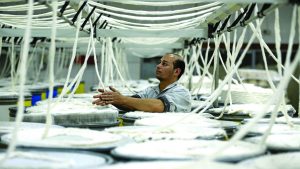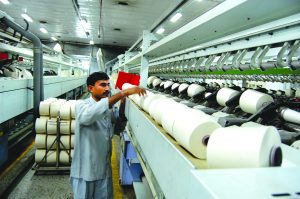 Textile industry was the key sector that led to the Industrial Revolution in late 18th century that spread across the globe. A total of 59 textile parks have been sanctioned under the Scheme for Integrated Textiles Park (SITP) by the Ministry of Textiles out of which 22 textile parks have been completed. Has the scheme served the very purpose for which it had been formulated?
Textile industry was the key sector that led to the Industrial Revolution in late 18th century that spread across the globe. A total of 59 textile parks have been sanctioned under the Scheme for Integrated Textiles Park (SITP) by the Ministry of Textiles out of which 22 textile parks have been completed. Has the scheme served the very purpose for which it had been formulated?
One of the key driving factors for industrial transformation was the promotion of industrial clusters, geographical agglomerations of firms and hubs of production, which was seen as a viable solution for economic growth and competitiveness. The Government is implementing the Scheme for Integrated Textile Park (SITP) which provides support for creation of world-class infrastructure facilities for setting up of textile units, with a Government of India grant up to 40 per cent of the project cost subject to a ceiling of 40 crores.
However, Government of India grant is up to 90 per cent of the project cost for first two projects (each) in Arunachal Pradesh, Assam, Manipur, Meghalaya, Mizoram, Nagaland, Tripura, Sikkim, Himachal Pradesh, Uttarakhand and Jammu and Kashmir with ceiling of 40 crores for each textile park.
A study report submitted to Ministry of Textiles by Wazir Advisors, a management consulting firm focused on advising clients in sectors of Textile, Apparel and Technical Textile stating that though a majority of the parks are functional, atleast eight had applied for cancellation. The functional parks are involved in production of spun yarn, fabric weaving and knitting, fabric processing, garmenting, made-up manufacturing, and technical textiles.
There were 11 parks which got cancelled earlier, mainly due to land related issues such delay in conversion, clearances, disputed lands and even non-availability. The other reasons that led to park cancellation were delays in sanctioning and differences between SPV members.
The report says that out of the functional parks, only few parks are fully functional while the rest are still looking for investors. Since most of the parks are partially functional, they have not been able to achieve the integration in real sense. There is lack of coordination among the units in the park as even though units of different value chain steps are present in a park but they are mostly not integrated with each other. In many instances, products being manufactured by upstream units are not of the type required by the downstream ones while in some instances the upstream units are unable to meet the downstream demands.
The report says that as most of the parks are of the size from 25 to 75 acres hence the Scheme has had limited impact in bringing scale to the textile industry. It has recommended that the participation of State Governments should be enhanced by sensitizing state governments for supporting parks approved by means of consultation platforms. It has also recommended the inclusion of state government nominee in SITP Project Scrutiny Committee and in Board of Directors of the Park. Then the Scheme should be amended to improve the ease of doing business and improve investment attractiveness by reducing the minimum number of promoters required, removing the requirement to submit bank appraisal report along with the proposal, modifying Technical Evaluation Criteria to remove weightage for State IDC involvement etc.
In the meanwhile, the Ministry of Textiles in its annual report released on December 27, 2019 claimed that the technical textiles is the harbinger of many new age applications covering almost all walks of life, and having immense potential for bringing in higher level of productivity, efficiency, cost economics; and offering innovative solutions to many engineering and general applications. In addition to their commercial use, technical textiles have been identified for mandatory use across various important missions, programmes and schemes of the Government of India.
Some of these are National Health Mission, Jal Jivan Mission, National Horticulture Mission and infrastructure development of highways, railways and ports. To boost a rapid growth of the technical textile segment in the country, 207 technical textiles items have been brought under separate head in the Harmonised System of Nomenclature (HSN) code under the Foreign Trade Policy.
With a view to derive the benefits of technical textiles in various fields of applications, currently 92 application areas have been identified for mandatory use across 10 Central Ministries. The Bureau of Indian Standards (BIS) has developed standards for 348 technical textiles products. On request from the Industry, Ministry of Textiles has included 6 additional courses for technical textiles in its Skill Development Programme called Samarth.
 In terms of the projections of the last baseline survey on technical textiles, the market size in India is projected as 1,16,217 crores. Although, there is no projection in the last baseline study with regard to the projections for the 2020-21, taking into account the current trend of growth and various initiatives of the Government, domestic market size of the technical textiles is expected to cross 2 lakh crores by the year 2020-21.
In terms of the projections of the last baseline survey on technical textiles, the market size in India is projected as 1,16,217 crores. Although, there is no projection in the last baseline study with regard to the projections for the 2020-21, taking into account the current trend of growth and various initiatives of the Government, domestic market size of the technical textiles is expected to cross 2 lakh crores by the year 2020-21.
The ministry claimed that the usage of Agro textiles in the North East Region has led to average increase in farmers’ income by 67 per cent to 75 per cent. Increase in intensity of crop cycles by 3 to 4 crops in a year is seen as there is cultivation throughout the year. It has led to reduced water consumption by 30 per cent-45 per cent and has prevented damages to crops due to birds and hailstone. Use of Geotextiles in infrastructure projects has led to improvement of serviceability of the infrastructure and increased maintenance intervals for infrastructure such as roads and hill slopes.
The Government of India, participated in World Cotton Day celebrations observed from 7th October to 11th October 2019 at the World Trade Organisation (WTO) in Geneva. The WTO organized the World Cotton Day event in collaboration with the Secretariats of the United Nations Food and Agriculture Organization (FAO), the United Nations Conference on Trade and Development (UNCTAD), the International Trade Centre (ITC) and the International Cotton Advisory Committee (ICAC).
Union Minister of Textiles, Smriti Zubin Irani, participated in the plenary session of the event which was attended by heads of states and heads of international organisations. WTO hosted the event at the request of the Cotton — 4 countries, Benin, Burkina Faso, Chad and Mali to celebrate their official application for the recognition of 7th October as World Cotton Day by the United Nations. World Cotton Day celebrated the many advantages of cotton, from its qualities as a natural fibre, to the benefits people obtain from its production, transformation, trade and consumption. World Cotton Day also served to shed light on the challenges faced by cotton economies around the world because cotton is important to least developed, developing and developed economies worldwide.
Between 2011 and 2018, India implemented a Cotton Technical Assistance Programme (Cotton TAP-I) of about USD 2.85 million for seven African countries namely Benin, Burkina Faso, Mali and Chad and also Uganda, Malawi and Nigeria. The technical assistance focused on improving the competitiveness of the cotton and cotton-based textiles and apparel industry in these countries through a series of interventions which had significant outcomes leading to a demand for a follow on project.
At the Partners Conference in Geneva, Textiles Minister announced that India will launch the second phase of the Cotton Technical Assistance Programme (TAP) for Africa. In the five year long second phase, the programme will be scaled up in size and coverage and will be introduced in five additional countries, namely Mali, Ghana, Togo, Zambia and Tanzania. The Cotton TAP programme will now cover 11 African countries including the C4 (Benin, Burkina Faso, Chad and Mali).
The ministry’s view is that cotton is a global commodity that is produced all over the world and a single tonne of cotton provides year-round employment for five people on average. Cotton is a drought — resistant crop ideal for arid climates, it occupies just 2.1 per cent of the world’s arable land, yet it meets 27 per cent of the world’s textiles need. In addition to its fibre used in textiles and apparel, food products are also derived from cotton like edible oil and animal feed from the seed.
Under Powertex India, 4,797 looms have been upgraded under the in-situ Upgradation Scheme for Plain Powerloom and 44.98 crores have been released. In the Group Workshed Scheme 141 projects have been approved and 7.64 crores have been released. In the Yarn Bank Scheme 8 projects have been approved and 5.27 crores have been released. 12 Buyers Seller Meet organized at a cost of 1.35 crores. Nineteen Powerloom Service Centres have been set up at a cost of 4.58 crores.
For the development of the Indian silk industry patents have been obtained for 5 technology packages, 50 research projects have been concluded and 55 technology packages disseminated. 13885 persons have been trained under various programmes organized by the Research & Training institutes of Central Silk Board (CSB).
The total raw silk production has increased by 11 per cent (35,468 MT) during 2018-19 over the previous year 2017-18 (31,906 MT). The bivoltine raw silk production achieved a record production of 6,987 MT during 2018-19 by registering 18.95 per cent growth over previous year. Raw silk yield per hectare has increased to 105 kg during 2018-19 compared to 96 kg during 2014-15. The Textiles Ministry has taken various steps through the Central Silk Board (CSB) to protect the interest of the silk producers.
The ministry has also laid focus on the jute industry which occupies an important place in the economy of India and is one of the major industries in the eastern region, particularly in West Bengal. Jute, the golden fibre, meets all the standards for safe packaging in view of being a natural, renewable, biodegradable and eco-friendly product. It is estimated that the jute industry provides direct employment to 0.37 million workers in organized mill and diversified units and supports the livelihood of 4 million farm families. For the welfare of jute farmers the JUTE – ICARE (Improved Cultivation and Advanced Retting Exercise) has been launched to promote scientific practices related to Jute Cultivation for Quality & Quantity improvements. In order to facilitate modernization and up-gradation of technology in existing/ new jute mills and JDP units an incentive Scheme for Acquisition of Select Machinery (ISAPM) has been launched.
To support jute entrepreneurs to display and promote jute diversified products through retail outlets in Metro cities, State Capitals and tourist places Retail Outlet of Jute Diversified Products and Bulk Supply Scheme has been put in place. To promote the Indian Jute Industry, the Government has set up the Indian Jute Industries’ Research Association (IJIRA). A variety of research activities has been undertaken by IJIRA for enabling faster retting of jute plant, softening of hard root cuttings of jute and eco-friendly oil-free processing of jute.
The Comprehensive Handloom Cluster Development Scheme (CHCDS) is targeted at development of Mega Handloom Clusters covering at least 15000 handlooms with the Government of India contributing up to 40 crores per cluster over a period of 5 years. Eight Mega Handloom Clusters viz. Varanasi (Uttar Pradesh), Sivasagar (Assam), Virudhunagar (Tamil Nadu), Murshidabad (West Bengal), Prakasam and Guntur districts (Andhra Pradesh), Godda and neighbouring districts (Jharkhand), Bhagalpur (Bihar) and Trichy (Tamil Nadu) have been taken up for development. Under the CHCDS, around 1.75 lakh handloom weavers have been covered for which 131.91 crores has been released for various interventions during the last four financial years and the current financial year.
Under the National Handloom Development Programme (NHDP), based on the viable proposals received from the State Governments, 294 Block Level Clusters (BLCs) have been sanctioned in the country covering around 1.6 lakh handloom weavers for which 165.99 crore has been released for various interventions during the last four financial years and the current financial year. Under the MUDRA scheme loans were sanctioned to 35952 weavers with a total disbursement of 181.68 crore. 8611 handloom workers have been provided skill upgradation training. 7417 Hathkargha Samvardhan Sahayata (HSS) items have been distributed to 7285 beneficiaries.
letters@tehelka.com












